DIRECTED BY HENRY HATHAWAY/1945
STREET DATE: NOVEMBER 15, 2016/KINO LORBER STUDIO CLASSICS
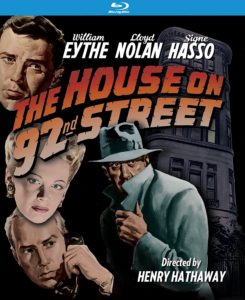 Filmed in part on the bustling streets of New York City, The House on 92nd Street proudly wields a wartime authenticity and urgency all it’s own. Highly rare was the film production that broke out of the physical artifice of the soundstage confines. The result is a unique work, curiously ahead of its time in some ways, but also more interesting than truly engaging.
Filmed in part on the bustling streets of New York City, The House on 92nd Street proudly wields a wartime authenticity and urgency all it’s own. Highly rare was the film production that broke out of the physical artifice of the soundstage confines. The result is a unique work, curiously ahead of its time in some ways, but also more interesting than truly engaging.
Producer Louis de Rochemont was best known for creating some of the earliest anti-Nazi material for March of Time newsreel series (circa 1938), blending footage of actual operatives with staged re-enactments. Therefore, it should come as no surprise when The House on 92nd Street opens with an unwieldy narrated segment that is just that. Much of the real life footage, shot from windows, cars, and rooftops, proves tangential to the later story, but as Film Noir expert commentator Eddie Muller points out on this blu-ray, the glimpses of actual secret agents skulking about while doing their thing, proved irresistible.
The House on 92nd Street proves to be more of a wartime curio than the Noir it’s now marketed as. At times it puts its mission ahead of its art, which results in a hodgepodge all its own.
Only later does it settle into a tale of an upstanding American double agent (William Eythe) doing his earnest to infiltrate the covert German ring of the enigmatic “Mr. Christopher”. The germans are in pursuit of nothing less than the American plans for the atomic bomb. The enemy has gone as far as to set up secret shop in F.B.I. headquarters itself, the building for which the film is titled. The ominous rooms and sharp attitudes evoke a Film Noir sensibility, prompting many to consider House just such a movie.
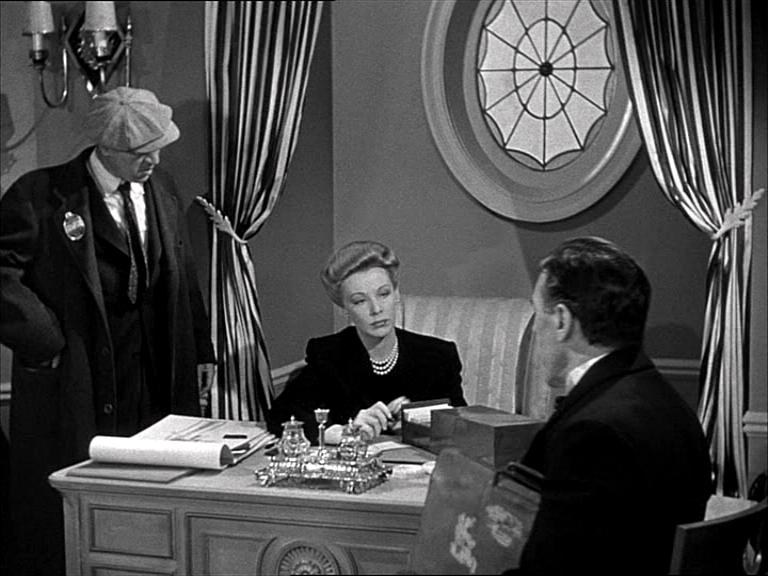
A web of sin!
The mailable nature of Film Noir is one of its greatest strengths but also it’s biggest frustration. It’s true that Noir films weren’t coined as such until their formal heyday ended, circa 1958. It’s also true that Noir is not a genre, but a style, a worldview, a mood, that was grafted onto films of the era, therefore the fact that exceptions to what constitutes true Noir are canonically numerous. (I.e., there are a handful of color Noirs, as well as happy-ending Noirs, and even horror and western Noirs). So yes, the Film Noir gate is wide. But has it gotten too wide?
1945’s House on 92nd Street is just such a slippery case, distractingly begging exception from the “Film Noir” label that marketing departments have slapped upon it. The historically nebulous definition of Film Noir, coupled with its continued popularity, has sometimes seemingly led to any old black & white movie getting labeled Noir, in the interest of moving units. But wide fedora brims, smoky rooms and window blind shadows alone do not Noir make.
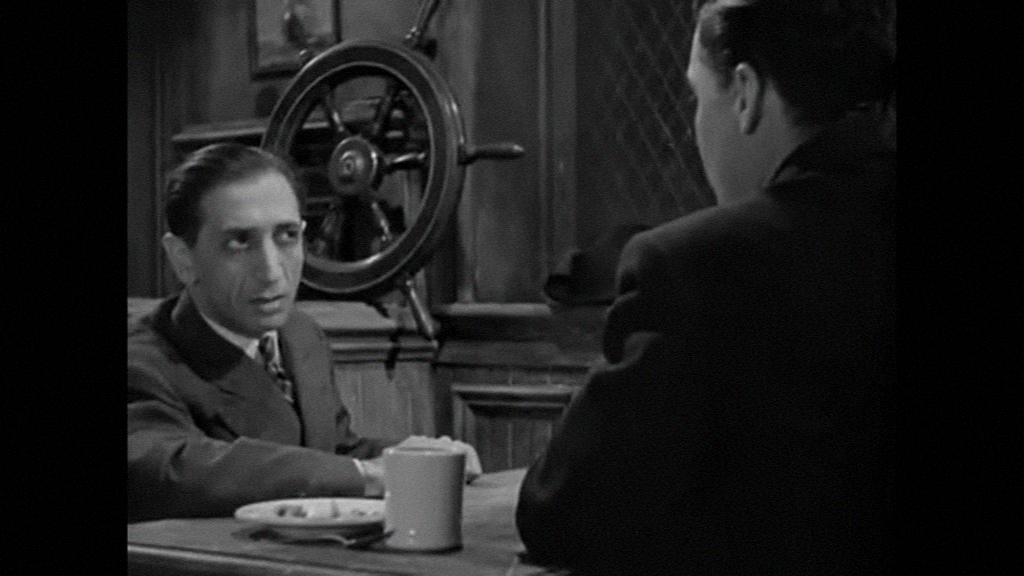
So what are we dealing with here? House on 92nd Street is first and foremost, by a wide margin, an America-first propaganda piece created in what turned out to be the twilight of World War II. Most interestingly, it incorporates and blends actual footage, real agents and government employees acting in the film, and conventional Hollywood storytelling featuring the likes of Leo G. Carroll, Gene Lockhart, and Lloyd Nolan It’s all about propping up J. Edgar Hoover’s F.B.I. as it worked tirelessly to infiltrate and bring down covert Nazi cells within the U.S.
Like so many F.B.I. centric films of its time and the generations surrounding, the reverence paid to Hoover and his department spans into the realm of fetishistic admiration. The patriotically charged music, the authoritative narrator, the low-angle, lingering shot of the Federal Bureau of Investigations building… all accounted for, and then some. Of course, this being technically a wartime film, much of this is entirely passable. But through a Noir lens… who’s dark night of the soul is this, anyway?
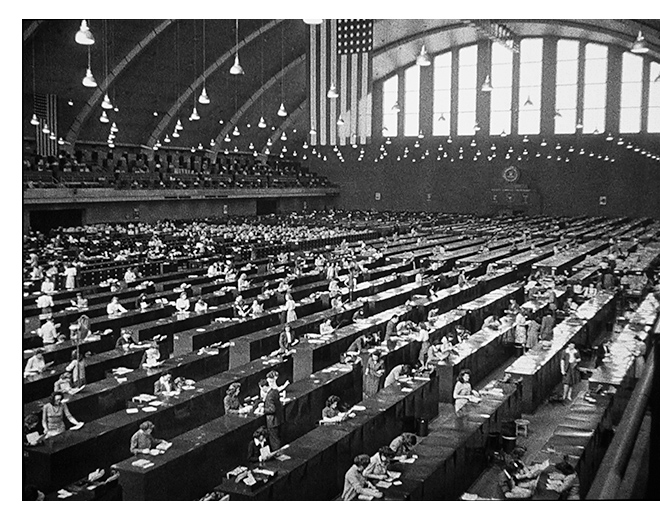
A glimpse into actual F.B.I. headquarters!
Once the documentary dust of its first ten minutes, it falls into being a spy caper. The film knows it’s at its coolest when it’s fixating on then-cutting edge surveillance: secret two-way mirrors, tricked-out medicine cabinets, coded messages and their subsequent decoding, disguises, and the like. Producer de Rochemont was clearly looking to make an of-the-moment proto-Bond movie; a true to life spy thriller that played like an inside look at actual F.B.I. counter-Nazi procedure.
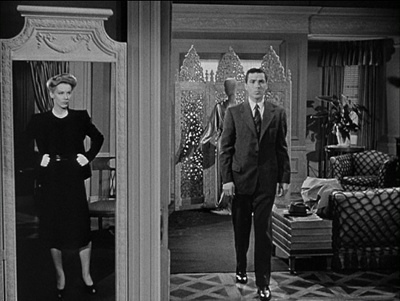 Director Henry Hathaway, by this point well established as a director, but not yet having made his signature works (True Grit, The Sons of Katie Elder, Rawhide), it to some degree along for the ride with this production. He brings out a certain humanity in the villainous Nazi agents, and clearly seems to dig the opportunity to film actors on the real streets. But formally and contextually, this is de Rochemont’s show. That said, the final showdown definitely delivers.
Director Henry Hathaway, by this point well established as a director, but not yet having made his signature works (True Grit, The Sons of Katie Elder, Rawhide), it to some degree along for the ride with this production. He brings out a certain humanity in the villainous Nazi agents, and clearly seems to dig the opportunity to film actors on the real streets. But formally and contextually, this is de Rochemont’s show. That said, the final showdown definitely delivers.
The House on 92nd Street proves to be more of a wartime curio than the Noir it’s now marketed as. At times it puts its mission ahead of its art, for certain, which results in a hodgepodge all its own. But it nonetheless deserves this quality release onto blu-ray. It’s high definition transfer is entirely satisfying, and arrives with a handy commentary by previously mentioned Film Noir Historian Eddie Muller. Muller is more admiring of this film than this writer, while also thankfully in agreement than this isn’t Noir at all.
The images used in the review are present only as a reference to the film and are not meant to reflect the actual image quality of the Blu-ray.

